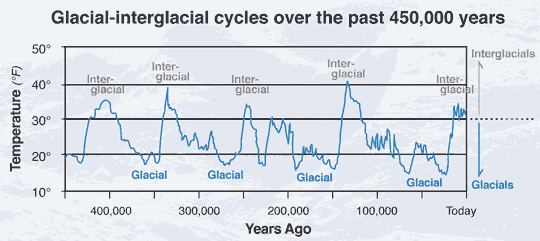FFS people... we are in an ice age and you want the planet to be colder?
Actually, that remains a bit debatable. Per this chart, we may still be in an "inter-glacial"~'warm period', but as the chart shows, for the past half million years about 80-90 percent of the time spent in either trans-glacial (that 30-20 degree band) easing into or jumping out of the glacials=Ice Ages, or actually in a glacial=ice age.
Some of those warmer "inter-glacials" a bit short lived, about 5,000 years or so, and others a bit longer in the 20-40,000 years or so. At the present, we've been in one of about 12-15,000 years duration, depending when and whom is doing the counting. But we could easily be on the verge of a decline and sometimes the drop can happen within a life-time, century or so.
Climate Crash
As scientists carefully search for clues in the sun and…

www.goodreads.com
Notice also that per this graph, three of the past four "inter-glacial" warm periods show temperatures that were higher~warmer than what the world is experiencing now.
However, your point is one for concern, as if we aren't careful and engage too much poorly conceived geo-engineering to counter the hypothesis of ACC/AGW we could trigger that sudden and rapid descent into another glaciation~ice age.
The term ice age can refer to the period from ~2.7 million years ago until today which is when the earth transitioned from a greenhouse planet to an ice house planet. There have actually been ~30 glacial / intergalcial cycles since that time. The term ice age can also refer to a glacial cycle during the present ice age which is how you took it. But I am really talking about is the bigger picture of how our planet is currently configured for bipolar glaciation. It is literally idiotic to want to reduce atmospheric CO2 and make the planet colder.
Most people think there have only been 4 glacial cycles or so but those are just the major ones of the past 400,000 years. Clearly the trend has been towards bigger and more severe glacial cycles. But they began happening ~2.7 million years ago. It coincided with the planet becoming susceptible to bipolar glaciation which is a new thing for the planet. The background conditions which led to it are isolated polar regions from the warmer marine waters, rise of panama isthmus, rise of the Himalayan mountains and atmospheric CO2 of 400 ppm. Conditions which still exist today. Extensive continental glaciation occurs at the south pole at ~600 ppm and 280 ppm at the north pole. The different thresholds of glaciation is because the south pole has a continent parked on top of it whereas the north pole has an ocean which is mostly isolated from the warmer marine currents. So it's harder for ice to form at the north pole than it is the south pole. Not surprisingly, it is the northern hemisphere glaciation which drives the climate of the earth.
Since becoming an ice house planet ~2.7 million years ago temperature swings have become more drastic and more frequent. The planet is poised to become cold. The planet is not poised to become hot.
OK ~ Given that context I see what you meant and agree totally.
It's that undercurrent of warmer water at the North Pole which makes for a thin ice sheet which the USS Nautilus, first USN nuclear powered submarine, was able to punch through back about 1954ish.
Not only has Earth's surface~continents been in continual flux~change over the past 4+ billion years, but so has the corresponding atmosphere and climates.
...
Second atmosphere
Outgassing from
volcanism, supplemented by gases produced during the
late heavy bombardment of Earth by huge
asteroids, produced the next atmosphere, consisting largely of
nitrogen plus
carbon dioxide and inert gases.
[41] A major part of carbon-dioxide emissions dissolved in water and reacted with metals such as calcium and magnesium during weathering of crustal rocks to form carbonates that were deposited as sediments. Water-related sediments have been found that date from as early as 3.8 billion years ago.
[42]
About 3.4 billion years ago, nitrogen formed the major part of the then stable "second atmosphere". The influence of life has to be taken into account rather soon in the history of the atmosphere, because hints of early life-forms appear as early as 3.5 billion years ago.
[43] How Earth at that time maintained a climate warm enough for liquid water and life, if the early Sun put out 30% lower solar radiance than today, is a puzzle known as the "
faint young Sun paradox".
The geological record however shows a continuous relatively warm surface during the complete early
temperature record of Earth – with the exception of one cold glacial phase about 2.4 billion years ago. In the late
Archean Eon an oxygen-containing atmosphere began to develop, apparently produced by photosynthesizing
cyanobacteria (see
Great Oxygenation Event), which have been found as
stromatolite fossils from 2.7 billion years ago. The early basic carbon isotopy (
isotope ratio proportions) strongly suggests conditions similar to the current, and that the fundamental features of the
carbon cycle became established as early as 4 billion years ago.
Ancient sediments in the
Gabon dating from between about 2.15 and 2.08 billion years ago provide a record of Earth's dynamic oxygenation evolution. These fluctuations in oxygenation were likely driven by the Lomagundi carbon isotope excursion.
[44]
...

en.wikipedia.org



